Newsletter Autumn 2005
EQUINE CHIROPRACTIC
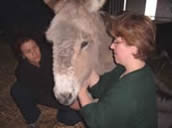
Sue Brown working with Maudie
The donkeys have enjoyed extraordinary privileges this summer starting with a surprise visit from Sue Brown of Chicago, USA, human and equine chiropractor. Sue developed a new “soft touch” chiropractic technique which does not involve heavy manipulation and is therefore well suited to working with animals. Some of the most damaged donkeys were taken “under hands” to experience the benefits of this particularly gentle but undeniably dynamic healing technique.
The results were startling in most cases. One very damaged donkey, Friend, obviously experience dramatic relief from pain in his spinal area: his back, which was always humped and painful to the touch, relaxed into a normal outline and Friend has been far more mobile since.
Maudie, who could only shuffle along with pathetically tiny steps, experienced a loud, involuntary cracking sound from the backbone and has been able to walk normally since. Shelley, who had problems in her neck area, preferred to keep her own company and stayed inside most of the time now ventures out with the others and is obviously far more comfortable grazing than she was before. Said Sue: ”Every time I treat equines I vow I will not go back to treating humans - animals are just so responsive and rewarding to work with!” Fortunately for us humans, Sue doesn’t keep this promise........not yet anyway!
TOOTH FAIRY
While most people were relaxing on the May Bank Holiday, Equine Dentist Lisa Molloy from Drumshanbo, and her colleague and friend, Sally Kingsley from Yorkshire in UK, were hard at work at the Sai Sanctuary where they corrected the teeth of 21 donkeys. The day’s work was funded from the ex-gratia payment which was bestowed on the Sanctuary last December from the Department of Agriculture and Food, in order to support our work with equine welfare.
Most of the animals treated were elderly or would have health problems of some sort: almost all donkeys over a few years’ old have problems with their teeth stemming largely from living out their lives in, what is to them, an unnatural environment, eating soft rich grass instead of the dry, tough, fibrous fodder of their indigenous semi-desert areas of Africa and Asia.
The problems are many and varied and almost all can be corrected quite easily by a qualified equine dentist. Older animals commonly starve to death simply because their teeth need treatment.
The most usual problem is caused through general wear and tear which results in razor sharp edges on the sides of the molars. This results in lacerations to the insides of the cheeks when the animal chews, causing pain and abcesses. Occasionally uneven growth of teeth causes the jaw to lock, disallowing the necessary sideways movement needed to properly chew the food and resulting in spillage and “quidding”. A lost tooth allows its opposite member to grow to excessive lengths as it has no grinding surface on which to wear down (donkeys’ teeth continue to grow until they are about 25 years, when the top teeth start to wear back); in extreme cases the overgrown tooth will pierce the opposite gum making eating impossibly painful. Build up of tartar on the teeth causes inflammation of the gums, abcesses and pain.
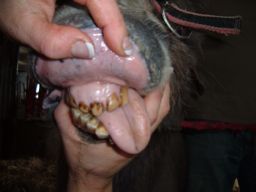
One of the Sai donkeys, (pictured) had had her jaw broken at some stage in her life so her entire mouth needed to be reshaped, and dead and broken teeth extracted so she could eat comfortably again. The whole process may take up to an hour for each animal and sometimes requires sedation which must be performed by a qualified veterinary surgeon. It may seem an expensive exercise to some people but to the donkeys (and other equines) it is a wonderful relief to be able to eat without pain, and the savings on feedstuffs soon recompenses the outlay on dentistry fees.
Lisa may be contacted on 086 8614396
AND HOOF DOCTORS
Shortly after having the teeth treated all the donkeys, ponies and horses received their regular care and repair work from our stalwart, long suffering, farriers Mark and Mick whom we wish to thank for their consistent and reliable service and for the many favours they extend to us as a registered charity. Thanks lads! Thanks too to vets Sabine and Evi for prompt and compassionate service often “out of hours”.
As always we have many, many people to thank, without whose help this small charity could not manage, including the ladies of the Sligo district ICA who donated €200 from the sale of St. Bridget’s Crosses, Jen Matthews who supplemented her earlier gleanings of a substantial amount of feedstuffs with wormers and other veterinary products, Liz and Kim who make a September holiday possible, Antjie and Dawey who held the fort to allow us to attend a family wedding in Holland and Judith R who gave a valuable week of her time to help with painting, ragworting, rescuing baby trees from being smothered by long grass in the new shelter belts and endless, grooming! To top this she gave a more than generous donation to help her new found friends.
RTE
Among the above we also thank Micheal O’Donagh who approached us for inclusion in an RTE programe in which he highlighted the increasing problem of continuous funding which challenges the smaller charities. This is not a situation exclusive to the Sai Sanctuary, or even only to animal welfare charities, though it is particularly relevant to the latter who cannot work solely from an “office” - be that the kitchen table or a rented room - but who absolutely require suitable buildings and land before ongoing, practical help can be administered to animals in distress. Most of the smaller animal sanctuaries and rescue organisations are built on privately owned property; are run by unpaid, voluntary workers and are largely funded from donations from the private sector. Without the recent support from the Department of Agriculture and Food many of the small animal welfare societies would find it impossible to continue their work in an economic climate where all supplies and services are dramatically increasing in price but where the expectaton is that we should continue to cover all aspects of animal care from policing/welfare, to veterinary, to lifelong sanctuary, all from our own resources. In an ideal world we need State employed Animal Police but until then we reaffirm than none of this work could be done without the willing support of people like YOU. It is your caring that makes it happen.
SPONSORED WALK
Finally our thanks go to ALL who have donated to the Sanctuary throughout the year or supported us in our fundraising events. Particular thanks go to Beate Graf who raised the amazing sum of €1,000 for our Crazy about Creatures sponsored walk, which we share with Sligo SPCA, and for the many others who raised considerable sums and joined us on the day. We totalled in excess of €2,400 for each charity.
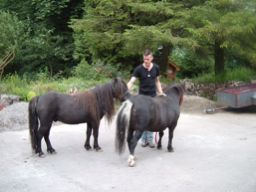
Bobby and Cobby
BOBBY and COBBY
Amongst our newcomers two little Shetland pony geldings, Bob and Com, joined the Sanctuary in August and were placed in a foster home only a few miles away where they will enjoy the family attention they were used to before their owner was taken ill and permanently hospitalised.
They are a gentle, friendly pair who just love to be fussed and petted.
AGGIE
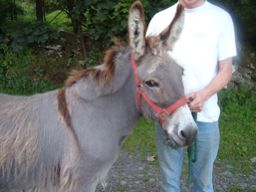
Aggie
An aged donkey mare, Aggie also joined us in August and was immediately adopted by Ezra Dumphy who has not left her side since. As they both came from the same area it is possible, of course, that they knew each other before, or may even be mother and son. Either way Dumphy has decided Aggie is his girl!
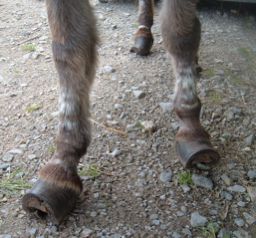
Aggie's hooves
Aggie is another gentle soul but not without spirit. Her hooves have been badly neglected in as much as they have been allowed to grow very long and then sawn off so walking is difficult for her.
If the people who indulge in this practise would realise that cutting the donkey’s hooves in this way is like cutting our fingernails at the “quick”, they may not be so hasty to take out the saw and mutilate the poor animals’ feet.
PEADAR AND LISA RETURN
Regular followers of the Sanctuary will remember two gorgeous donkeys who came to us for just over a year when their owner moved temporarily to UK to look after her mother. Peadar and Lisa were a happy pair who blended well into the Sanctuary herd, and we are delighted to be able to offer them permanent sanctuary now that their owner’s circumstances have further changed. It is a heart rending decision and one of courage to part with much loved pets, and it is a humbling experience for us to be entrusted with their care.
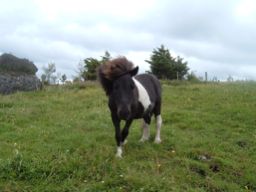
Billy Magpie
BILLY MAGPIE
This little fellow was bought from a horse sale with the proceeds of a donation to celebrate the 60th birthday of a dedicated ‘Friend of the Sanctuary’ who had stipulated to her family that presents were not on the agenda. Fortunately for Billy the family deviously had other ideas! Though not strictly abused Billy Magpie was in ropey condition with a big worm belly, poor coat, thin upper line and tangled, torn and tatty mane and tail though, unlike almost all of the donkeys admitted, his hooves were in good condition. At only 30 inches tall Billy is not the biggest guy on the block but soon staked his place with horses and ponies several times his size and now looks a different pony. Already he is a firm favourite with visitors!
FOSTER HOMES
It is rare for us to find foster homes with which we are truly happy and that are both on the doorstep and involve people who have the time and desire to care for these sometimes very damaged animals.
Bonnie, Tessa and Pandora are privileged to have been placed in a long term foster home in Co. Sligo. Their new carers are at home all the time so the three girls get far more attention and hands on care than was possible in the busy atmosphere of the Sanctuary. They will also greatly benefit from their carers experience as an acupuncturist and her dedication to their healing and well-being.
Charlie Girl was transferred into the care of a German couple, to keep company with their very lonely gelding donkey, Freddy. Charlie Girl is a timid little soul who was badly abused and who rarely gets the attention she deserves as she is overshadowed by the bolder donkeys in the Sanctuary herd. As long as Freddy is prepared to share his longed-for girlfriend with their human carers, it is hoped that Charlie Girl will be able to let her light shine more easily with Elke’s gentle one-on-one handling.
IMPROVEMENTS AT THE SANCTUARY
These include toilet facilities which are now available in the upper yard and which will be appreciated by both volunteers and visitors. The concrete floor in the long donkey shed has been raised by four inches to prevent further flooding.
A large area of hard standing has been made surrounding the new field shelter in the horse/pony section to provide a clean, dry area accessing the shed, where the animals can stand free of the inevitable muddy winter conditions and a gravel road has been laid between this area and the next field for easier access of animals and for feeding etc.
HOLIDAY COTTAGE TO RENT
We are delighted to announce the availability from December 2005 of our holiday cottage on site at the Sanctuary. The cottage has two bedrooms, one with double bed, the other with 4ft bed, a two seater bed settee and a short double bed on a sleeping loft above the sitting room, best suited for children and small people! Other facilities include bathroom, utility room, large kitchen/dining room and spacious entrance porch (ideal for essential wellies etc) OFCH and wood burner. It is fully equipped: linens can be provided or bring your own. The cottage affords a unique opportunity for enjoyment of a truly beautiful area rich in myth and legend, walking, fishing, spectacular views and most of all, donkeys and ponies galore! Rent €150 - €400 pw as per season. All enquires through the Sanctuary please.
CHRISTMAS AND GREETINGS CARDS
We have three Christmas designs again this year, all measuring 6 x 4 inch (148mm x 100mm), two in photographic format and one beautifully executed pen and ink drawing by our amazing friend Michael Gough. In addition we have a standard card which is blank inside.
All cards are priced at €1.10 (£1) each including envelopes, plus post and packing.
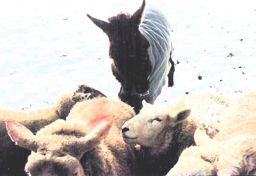 |
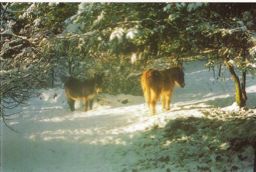 |
No 1 is called Sheep Donkey |
No 2 is called Winter Wonderland |
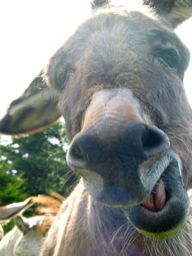 |
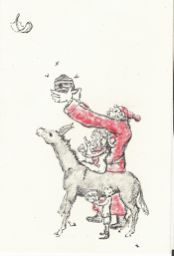 |
No 3 is blank for your own greeting |
No 4 is A feather from an angel’s wing by Michael Gough. |
HORSE MARTS
After an escalation of complaints about the treatment of equines at various horse marts, contact was made with the local welfare officers for The Donkey Sanctuary and the ISPCA Inspector for Sligo, Leitrim and Donegal with a view to discussion and a plan of action for the future. At present we are working with one particular Mart which is willing to cooperate with the introduction of a specific code of practise - simple adjustments like keeping stallions separate from mares and foals at all times; providing bedding for heavily pregnant mares and mares with tiny foals at foot; not mixing donkeys with horses as a general rule; not overcrowding the pens; unbroken stock to be herded in such a way that there is less risk of danger either to themselves or the public. Many of these requirements sound obvious but are difficult to implement in the heat of a busy and understaffed market. However,we believe that with the goodwill of the Mart manager and his staff considerable improvements will be made.
DANGEROUS HALTERING
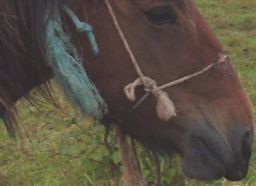
The picture shown below is necessarily shown quite large as it illustrates the suffering caused by using rope for a makeshift headcollar or halter. In this instance it is believed the halter was placed on this pony because he was difficult to catch. It was undoubtedly tied too tight in the first instance and put on dry. Later when the rope became first wet in the rain, and dry again, it shrunk, tightening around the poor animal’s nose with the results shown. ANY halter placed on a horse, pony or donkey should have at least one inch (two and a half cms) free space between it and the nose bone and rope halters should NEVER be used except as a temporary measure. If it is absolutely necessary to leave on a headcollar, then a properly fitted leather or webbing headcollar should be used and CHECKED DAILY for signs of rubbing, discomfort and wear. Often the buckles and other metal fittings on even the best headcollars can cause considerable abrasions if they are chafing for any length of time.
The pony shown to the right will be scarred for life with white hair growth where the rope had embedded in the skin to a depth of one cm over the nose and nearly 2 cm under the chin. Another danger area for friction abrasions are all weather turnout rugs left on for long periods and which should be checked regularly for signs of chafing, especially along the withers, across the chest and around the legs if the rug has leg straps. Your donkey, horse or pony will appreciate this little extra care shown to his comfort and reward you with his affection and enjoyment at being handled by you.